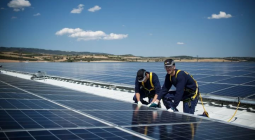Solar is key to the success of the future’s cities.

Solar and IoT hold the key to modern urban landspaces if properly secured, guest author Chris Jones, tech expert from U.S. based activist group TurnOnVPN elaborates.
There’s been a lot of buzz around smart cities of late, and as we currently stand near the end of the 21st century’s first quarter, smart city ambitions are becoming a reality.
Cities that utilize the latest internet of things (IoT) technologies and renewable energy sources are well placed to enhance the quality of all urban infrastructures and services. Resources will be better managed and wastages and costs kept to a minimum.
Solar energy, along with other renewables such as wind, thermal and hydro energy sources, is key to the success of the future’s cities. Traditional energy sources are limited, increasingly expensive, and not sustainable in the long term. Demand simply cannot match production, and nor should it unless we wish to exacerbate the current climate crisis.
Smart cities will be heavily reliant on a steady flow of clean energy to maintain buildings, transportation, hospitals, factories and more. Digitalized services also rely on a smooth, consistent energy flow -- in many ways, the very foundation of a smart city is its power grid and connected services.
And to keep the whole of a city synched, connected and operational, IoT and cloud servers are crucial.
Serving up clean energy: IoT and solar
Solar is one of the most energy-efficient renewable energy sources on the market. And the fastest growing worldwide, in fact, capacity is increasing by around 40% each year. The future success of solar on a global scale is closely interlinked with solar companies maximizing their equipment’s potential through the use of smart grids.
Digital IoT tools provide solutions to many of the intricate challenges inherent with energy grid management, making it easier than ever to manage both panels and usages. Solar companies will find that IoT systems also assist with meeting customer demands in an efficacious manner. These days, the question is not whether to install an IoT system, but how to integrate digital technologies successfully.
Often, solar energy is garnered from a diverse and distributed group of assets, this poses a challenge even for the most technologically advanced companies with big budgets and plenty of engineering resources. Furthermore, because renewable energy sources are affected by weather and other environmental factors, the grid needs to adapt to fluctuations accordingly.
To ensure the best possible outcomes for both the energy provider and the customer, be it a smart city or an individual user, IoT professionals and engineers should work together to make sure the digital aspects and the physical aspects operate well in tandem.
The system as a whole also needs to be thoroughly checked for vulnerabilities. As a rule of thumb, the more complex the grid’s infrastructure is and the more devices connected to it, the greater the potential for vulnerabilities.
Security matters & the cost of breaches
With vulnerabilities, there are two key aspects: the physical security of the panels and the digital security of the IoT system and the data it generates. While the former is something solar companies have been working on for years, the latter presents new challenges to those companies who have wholeheartedly adopted IoT tech and smart grid systems.
Because any IoT device or connected system runs through a network, that network must be digitally secure to prevent data leaks and hacks. Handling customer data is a huge responsibility, one that utility companies have to take seriously, particularly when it becomes apparent just how much a data leak can cost: an average of US$ 3.5 million.
Let us show you the highlights of The smarter E in Munich, join our pv Guided Tours
Interestingly, according to IBM, only 47% of breaches are the result of criminal activity, the remainder is the result of glitches or human error.
For smart cities to fully embrace IoT-facilitated clean, renewable energy sources, security has to be prioritized, otherwise, city decision-makers may hesitate to implement the newer digital technologies.
Data from Ponemon Institute’s research study shows that utility providers should do three key things to mitigate breach risk: develop a solid incident response team; extensively utilize the latest encryption technology (one of the many uses of a VPN); and employee training that encompasses new information security procedures and considerations.
Properly secured, digital grids and connected cities have to potential to provide a clean, bright future. (HCN)
*Title photo: Properly secured, digital grids and connected cities have to potential to provide a clean, bright future, tech expert Chris Jones from NGO TurnONVPN says.
23 March 2020
pv Europe




